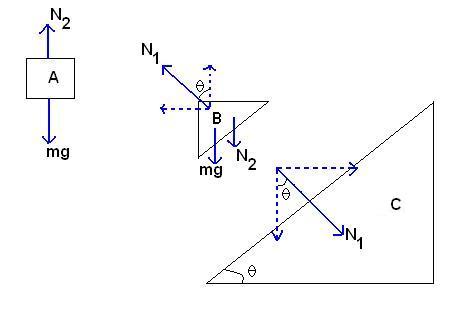The remaining ones?
A. 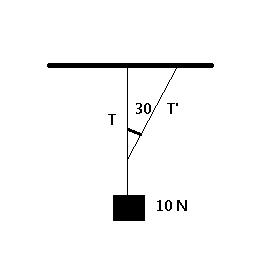
Then: (One or more may be correct)
1.) T = 5 N
2.) T = 10 N
3.) T' = 5 N
4.) T' = 0
B.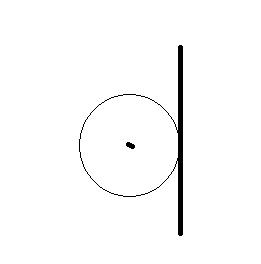
Weight of sphere = W and a force P is applied on its surface to attain equilibrium (Friction is present). Then
1. Pmin = √3W/2
2. Pmin = (√5-1)W/2
3. When P is minimum, Angle of friction max between sphere and wall is cos -1 (√5-1)/2
4. When P is minimum, Angle of friction max between sphere and wall is tan -1 (√3-1)/(√5-1)
-
UP 0 DOWN 0 1 35

35 Answers
pata nahi answer wrong kyu ara hai LOL [3]
btw euclid i tried wid d same way dat u r telling , but pata nai ans match nai hora
btw vivek wats d source of the question ?
i solved it dis way
aB/C= [- aB/C cosθ] (i ) + [- aB/Csinθ] (j)
(since B moves only along d incline as seen by C )
aC = aC (i )
→ aB = aB/C + aC = [aC - aB/C cosθ] (i ) + [- aB/Csinθ] (j)
aA = aA (j ) [ no i component as no force in x direction )
also , since A never loses contact with B, A has accn only in horizontal direction AS SEEN BY B ,hence a(A/B)y= 0 i.e (aB)y = (aA)y
so aA = [- aB/Csinθ] (j)
now Σ m a x-component= 0
so aC+ aC - aB/C cosθ = 0
aB/C cosθ = 2aC
so aB = - aC (i )+ [- 2aCtanθ] (j) ..........( 1 )
so aA = (aB)y (j ) = [- 2aCtanθ] (j) .........( 2 )
let N1 = normal force of B on C , N2 = normal force between A and B
N1sinθ = maC
mg + N2 - N1cosθ = m( aB )y = 2maCtanθ
mg - N2 = m(aA)y= 2maCtanθ
so 2mg - N1cosθ = 4maCtanθ
2mg = maCcotθ + 4maCtanθ
so , aC = 2gtanθ1+4tan2θ
Ohh... Sorry but the answer isn't matching.. I don't whether you have done correct or not cause I couldn't understand it at all :P
One question more here: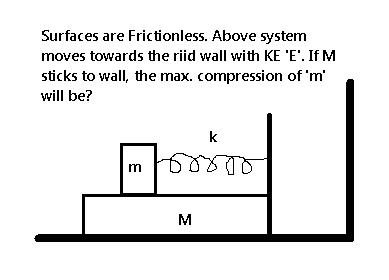
Kafi pass pahuch gaya hai.. The exact answer is
Ac=\frac{2gsin\theta cos\theta }{1+3sin^{2}\theta} or, \frac{gsin2\theta }{1+3sin^{2}\theta}
arey idiot mahashay(Vivek), answer right hai. itna natak mat karo, exact answer, exam mein answer dekh kar qwerty right answer hi mark karta.
@ Euclid (we know that relative accln betn two bodies in contact along the perpendicular direction is zero)
But this thing couldn't make to my brain. Someone explain it clearly please.
@Khyati I'll mail you :P :P
Plz try other people
B.) A mass m is put on an inclined plane of angle theta and tied with a light thread present the upper end of incline (Shown below). Friction coeffn k is present. Now theta is increased from 0 to 90, then
1. Tension in thread versus theta
2. Normal on the block vs. theta
3. Friction on the block vs theta
4. Net interaction force between block and Incline versus theta
2) N = mgcosθ, so as θ increases N decreases.
3) k = μN = μmgcosθ, so again as θ increases k decreases.
1) T is proportional to sin θ, so as theta increases then T also incraeses
using this info plot the graphs.
Nice!! I think I solved it the same way, but When it comes in matrix type it becomes confusing.
2 still to go!!
well you have the habit of getting confused when easy questions are asked, so there is no difference if they are asked in matrix match or somewhere else.[3]
If you're solving it, then please let us know. COM concept is involved or not? If yes, Is there any other method for it?
( i m not sure if i hav interpret the question correctly )
initially system is moving with KE = E = 12mv2 +12 Mv2 = (m+M)v22
velocities of m and M will be equal initially , or else the 2 ends of spring will hav different velocities, leading to deformation in spring , wich will giv rise to PE of spring at the cost of KE of m and M ,and thus KE will keep on changing , but since KE is given as E( i.e constant ) their velocities will be equal
so
KE with m = mE(m+M)
as M sticks to wall,after colliding its KE = 0
now after collision, energy of system = PEspring + KE m
= constant = Eo
just after collision , PEspring= 0 ,KE m = mE(m+M)
so Eo= mE(m+M)
PEspring is max i.e extension of spring is max when KE m =0
so Eo= mE(m+M) =12kx2max
so xmax = √2mEk(m+M)

I was missing the bigger block.. Thanks qwerty and thanks to all!!
One to go!
#10 Q1 ekdam lallu question hai , why isnt any one trying ??
hint : A will hav accn only in vertical direction ( think why ?)
SO only C and B hav accn in horizontal direction , now since COM has zero accn in x direction , accn of C =accn of B in horizontal direction
Q2 bhi easy hai
For the first question if the figure is correct then clearly T'=0 and T=10N
Reason, T' one string is only tied no force is acting on it like pulling
you can imagine like first you tied that block by vertical string then tied other string to the block at the given angle to the ceiling. That string doesn't has any tension in it.
First is simply, (Mathematical deduction)
T'sin30 = 0 => T' = 0 N
and T+T'cos30=10 => T = 10 N
Well, That was just and refresher and all of you are quite correct. Any Ideas for the second one?
@Euclid, Sorry no friction coeffn is given. The answers are (B,C).
But I don't know how!!
A.) 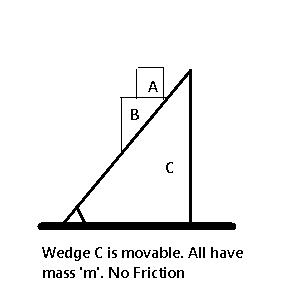
Find -
1.) The accn of Block A w.r.t ground.
2.) The Accn of block B w.r.t ground
3.) The Accn of Block C w.r.t ground.
And If you want to do more, may be we can add their relative ones.
B.) A mass m is put on an inclined plane of angle theta and tied with a light thread present the upper end of incline (Shown below). Friction coeffn k is present. Now theta is increased from 0 to 90, then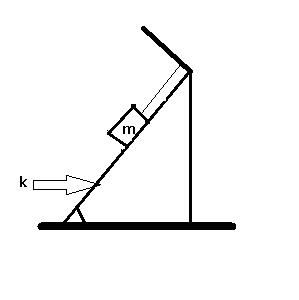
Plot -
1. Tension in thread versus theta
2. Normal on the block vs. theta
3. Friction on the block vs theta
4. Net interaction force between block and Incline versus theta
for 2 i think the coefficient of friction should be given...
Pmin = W / √(1+Ï
2)
